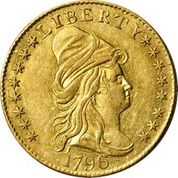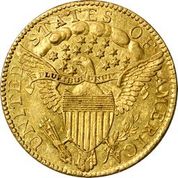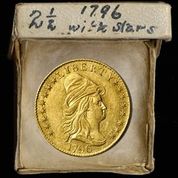
PREV ARTICLE
NEXT ARTICLE
FULL ISSUE
PREV FULL ISSUE
1796 QUARTER EAGLE EX-ELMER SEARSLast week we mentioned dealer Elmer Sears. Stack’s Bowers Galleries Numismatic Acquisition Coordinator Ron Gillio passed along this upcoming auction lot description for a nice 1796 Quarter Eagle sold by Elmer Sears in 1926. Thanks! -Editor 1796 Capped Bust Right Quarter Eagle. Stars on Obverse. B-3. Rarity-5+. MS-62 (PCGS). This is one of the most significant and exciting offerings in this sale - a fresh Mint State 1796 Stars Obverse quarter eagle that has only recently been certified by PCGS for the first time and is making its debut in the modern numismatic market. It is a poster example of a classic early U.S. Mint gold rarity. Vivid surfaces exhibit deep olive undertones to brighter golden-apricot color, wisps of pale pinkish-rose also evident as the coin rotates under a light. The striking detail is generally bold to sharp from a nicely centered impression, and while isolated high points are a tad soft, many other features are fully rendered and crisp. Semi-reflective in the fields with a satiny texture otherwise, the surfaces are uncommonly free of sizeable marks for both the issue and the assigned grade. Remarkably fresh and original in appearance, quite unlike so many early gold coins encountered in today's market. In sum, this is a lovely coin and outstanding representative of the issue that would serve as a highlight in the finest gold cabinet. BD Die State d. The Coinage Act of April 2, 1792, authorized the production of three gold denominations at the newly established Mint: the $10 eagle, $5 half eagle, and finally the $2.50 quarter eagle. It would not be until four years later that the first quarter eagles rolled off the presses. This was no grand undertaking in terms of quantities: while 6,196 half eagles and 4,146 eagles were coined in 1796, scarcely 1,395 combined of both varieties of 1796 quarter eagles were delivered. The half eagle turned out to be the most popular of the three denominations for general commerce, while the eagle was useful for large overseas transactions with Europe. The quarter eagle, however, did not prove especially useful in everyday commerce. In the Mint's early days, precious metal coins were made to order by depositors who requested specific denominations, and the quarter eagle's bigger siblings received most of the attention. The denomination was struck only erratically and generally in small numbers in its first dozen years before production was put on hold after 1808. The first 1796 quarter eagles minted featured an obverse without stars, an unusual choice considering the half eagle and the eagle both had stars as part of their obverse designs. Likely, they were omitted as there were stars on the reverse, although over the years quite a few federal coins have had stars on both sides. (The first $5 and $10 coins of 1795, continuing through 1797, had stars only on the obverse.) At some point in early 1797, a decision was made to add 16 stars (in an 8x8 configuration) to represent each state of the Union at the time and mark the admission of Tennessee in June of that year. This was the first and, as it turns out, the last time the obverse star count on quarter eagles was adjusted each time a state was added. For the entire 1796-dated quarter eagle issue, three die pairs using two obverses and three reverses were employed. Both obverse dies shared the same master hub and date punches. The three reverse dies all bear 16 stars and were made using the same master hub for the eagle, clouds, and the ribbon inscribed E PLURIBUS UNUM. The reverse hubs are believed to be by John Smith Gardner, and feature an eagle with a longer neck, visible tongue, two rows of tail feathers, and three claws visible on top of the talons clutching the arrows and branch. The later Scot hubs produced after Gardner left the Mint in 1796 have a shorter neck on the eagle, three rows of tail feathers, and a single claw on top of each talon. Only one set of dies -- the BD-3 die marriage -- was required to produce the entire run of 432 Stars on Obverse quarter eagles. Conventional wisdom indicates that they were all coined on January 14, 1797. Some research suggests that this batch may have also included some No Stars quarter eagles as part of the 432-piece mintage, with an additional 98 examples of the BD-3 variety delivered on February 28, 1797. As with most early U.S. Mint gold issues, a large quantity of 1796 quarter eagles ended up in the bullion speculator's crucibles during the 1820s and 1830s, leaving only handfuls for modern numismatists. The 1796 Stars on Obverse quarter eagle is much rarer than the earlier No Stars variety as a whole; perhaps only a third as many BD-3 pieces as BD-2 No Stars coins are extant (the No Stars BD-1 pairing is of exceptional rarity). At most, 40 to 50 of the Stars on Obverse variety are thought to survive, with maybe little more than a dozen at the Mint State level. Despite this, the status of the No Stars as a one-year design type has helped it capture much of the numismatic spotlight. However, the Stars on Obverse quarter eagle is attracting greater attention as more and more collectors and scholars come to appreciate its rarity.
Elmer Sears retired in 1918 and sold his dealer stock that same year through a series of B. Max Mehl auctions. (Wayte Raymond continued in business under his own name thereafter.) He was not finished with numismatics yet, however, and seems to have continued operating from time to time as a vest pocket dealer, selling coins from his personal collection and/or handling select high end pieces that came his way. He is known to have offered John Work Garrett a Brasher piece in 1925, and that same year Sears also referenced having met Garrett in Wayte Raymond's office "some year ago or so." The quarter eagle offered here, sold by Sears in August 1926, further confirms his continued activity in numismatic circles well after his retirement in 1918. He died in 1937. When and under what circumstances Sears acquired this coin are unknown. Was it set aside from his dealer stock as a personal favorite? Did it cross Sears' path after his retirement and provided the opportunity for him to make a special numismatic sale? Or maybe Sears acquired the coin with the specific intention of including it in his personal collection. We will never know. Also lost to history is the identity of the numismatist who acquired this coin from Sears in 1926, although he/she is probably the person who recorded the transaction on the small 30.5 mm x 30.5 mm cardboard box that accompanies this lot. Likely the box in which this coin was housed for decades, on one edge of the lid is written in black ink "2 1/2 1796 / WITH STARS," while on the bottom is written "1796 2. EAGLE / WITH STARS OBV. / UNC. 'GEM.' / FROM SEARS. / AUG 1926. / @ 350.00." The trail goes cold after the Sears sale, the coin next surfacing in the hands of Montrose, California dealer Herman Engelhardt, who sold it to a doctor at an unknown time. By the 1970s at the latest the doctor was living in La Canada, California, at which time he sold the coin to our consignor. Off the market for upward of 50 years, this coin was recently certified for the first time by PCGS in anticipation of its offering in this sale. We expect spirited bidding when this beautiful and highly significant example of a classic early gold rarity crosses the auction block. PCGS# 7647. NGC ID: BFVN. PCGS Population: 2; 3 finer (MS-65 finest). Ex Elmer Sears, sold in August 1926; unknown; Montrose, California dealer Herman Engelhardt, sold to the following, date unknown; a doctor in La Canada, California, sold to our consignor in the 1970s and off the market since that time.
To read the earlier E-Sylum article, see:
Wayne Homren, Editor The Numismatic Bibliomania Society is a non-profit organization promoting numismatic literature. See our web site at coinbooks.org. To submit items for publication in The E-Sylum, write to the Editor at this address: whomren@gmail.com To subscribe go to: https://my.binhost.com/lists/listinfo/esylum All Rights Reserved. NBS Home Page Contact the NBS webmaster 
|


